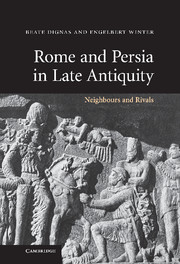Book contents
- Frontmatter
- Contents
- List of figures
- List of maps
- Preface
- Abbreviations
- Introduction: West and East, friend and foe, counterpart and mirror image …
- PART I NARRATIVE
- PART II SOURCES AND CONTEXTS
- Appendix 1 Lists of Sasanian kings and Roman emperors
- Appendix 2 Chronological table
- Appendix 3 Glossary
- Bibliography
- Index of sources
- Index of translated sources
- Index of names
- Index of place names
- General index
Introduction: West and East, friend and foe, counterpart and mirror image …
Published online by Cambridge University Press: 05 June 2012
- Frontmatter
- Contents
- List of figures
- List of maps
- Preface
- Abbreviations
- Introduction: West and East, friend and foe, counterpart and mirror image …
- PART I NARRATIVE
- PART II SOURCES AND CONTEXTS
- Appendix 1 Lists of Sasanian kings and Roman emperors
- Appendix 2 Chronological table
- Appendix 3 Glossary
- Bibliography
- Index of sources
- Index of translated sources
- Index of names
- Index of place names
- General index
Summary
Relations between Romans and Persians in late antiquity were bound to be turbulent, to say the least. We are looking at those who conquered the possessions of the heirs of Alexander the Great versus those who claimed to be the heirs of the Achaemenid Empire, which was conquered by Alexander the Great. ‘Heritage’ and its claims often foreshadow war, in this case centuries of warfare that lasted throughout the existence of the relationship between the two powers, i.e. the third to the seventh century ad. On both sides war was accompanied by complex attempts to justify their respective goals, in both active and reactive ways. Rome's claim for world domination was accompanied by a sense of mission and pride in Western civilisation; it was met by Eastern myths and oracles prophesying the downfall of the Western power. Our sources reflect strong Roman ambitions to become a guarantor of peace and order. Simultaneously, they reflect long-standing prejudices with regard to the Eastern power's different customs, religious structures, languages and forms of government. As a consequence, a wide gap separated the two cultures and negative attitudes that stemmed from existing political, military and economic rivalries were constantly reinforced. In the company of most ancient – and often Western – observers, it is tempting to associate our theme with an ‘everlasting’ conflict between West and East, between a ‘civilised’ Roman world and a barbarian enemy, and hence to describe the struggle between the two super powers as a clash of fundamentally alien cultures.
This approach is a phenomenon that applies not only to antiquity but also to the present day, possibly more than ever before.
- Type
- Chapter
- Information
- Rome and Persia in Late AntiquityNeighbours and Rivals, pp. 1 - 6Publisher: Cambridge University PressPrint publication year: 2007



